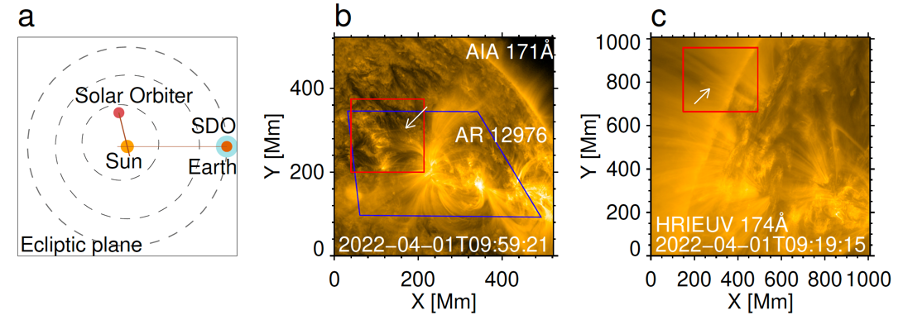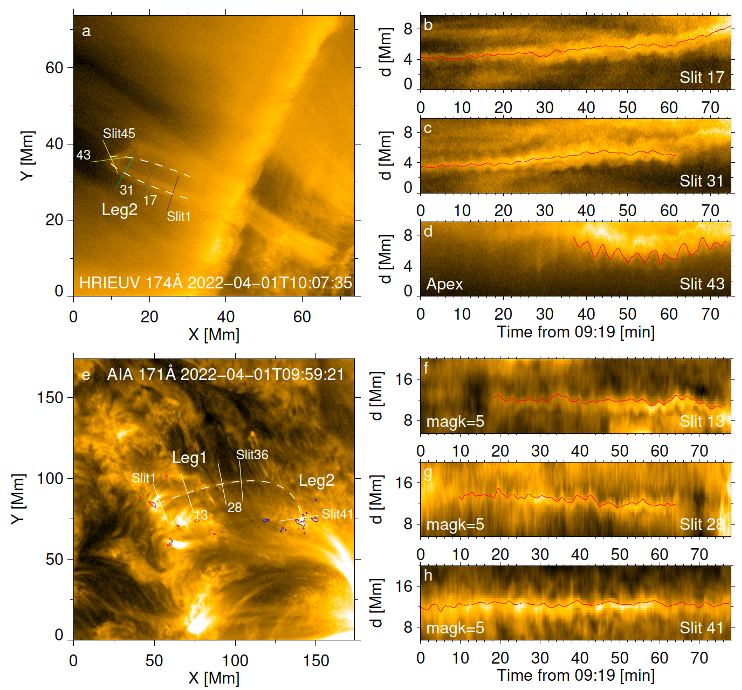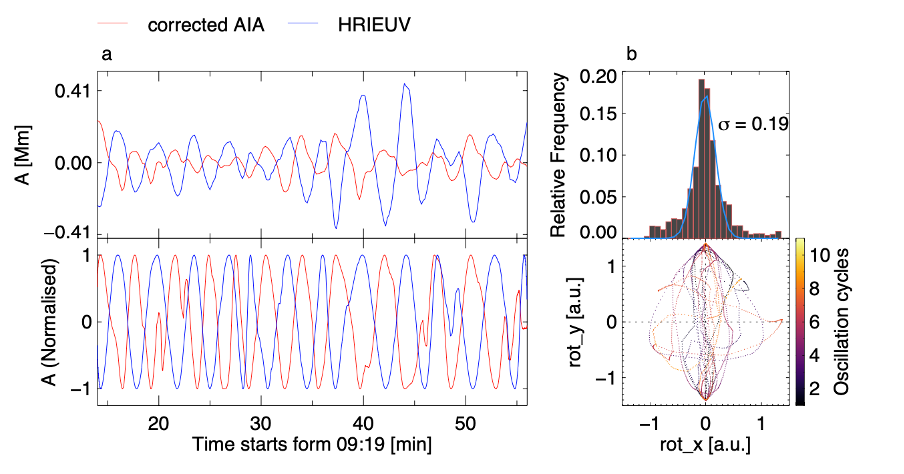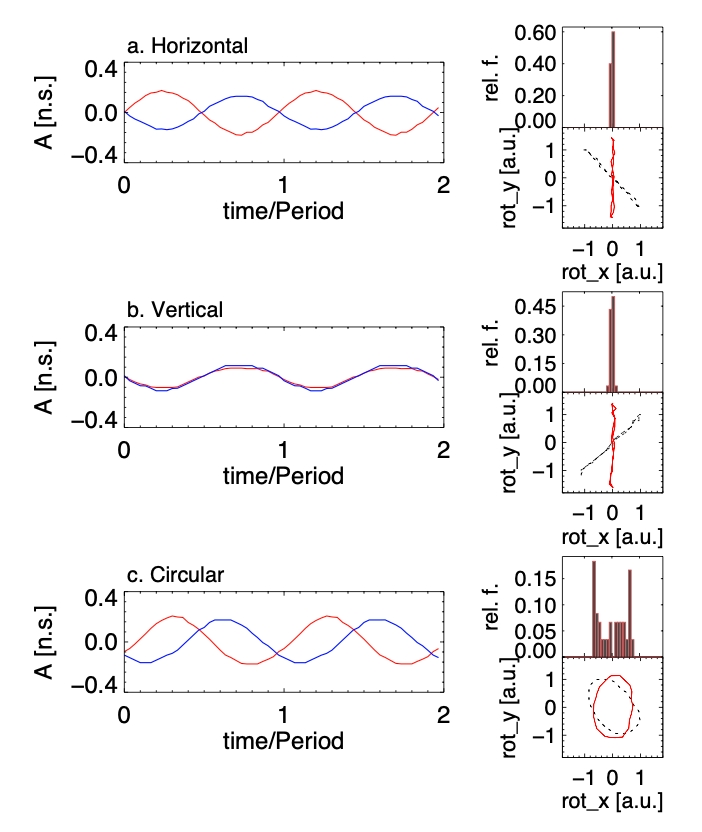Science nugget: Polarisation of Decayless Kink Oscillations of Solar Coronal Loops - Solar Orbiter
Polarisation of decayless kink oscillations of solar coronal loops
(Solar Orbiter nugget #15 by S. Zhong1, V. M. Nakariakov1, D. Y. Kolotkov1,2, L.P. Chitta3, P. Antolin4, C. Verbeeck5 & D. Berghmans5 )
Introduction
The unequivocal and persistently growing interest in studying wave and oscillatory phenomena in the corona is motivated by their use for plasma diagnostics [1], and for their potential contribution to the enigmatic coronal heating [2]. Recently discovered low-amplitude decayless kink oscillations [3] are among the most promising candidates for both those applications, as they are evidently observed almost in every coronal active region, especially during their quiescent phases (i.e., periods excluding solar eruptions).
However, the mechanism by which energy is continuously supplied to compensate the rapid damping typical for kink oscillations, is uncertain. Several theories have been proposed. Among them is a self-oscillatory model that invokes interaction between loops and quasi-steady flows [4-6], and the other being a model driven by random flows [7-9]. The quasi-steady external flows required by the self-oscillatory model could be granulation or supergranulation flows. The alternative interpretation is an apparent brightness caused by the Kelvin-Helmholtz Instability (KHI) and resonant absorption [9]. These possible mechanisms can be discriminated by the polarisation of the oscillations. The self-oscillatory model leads to linear polarisation of kink oscillations [5-6]; while in the random-driver model, oscillations are randomly polarised [8-9]. Yet the detection of the polarisation of decayless kink oscillations is challenging, as it needs either a combination of high-resolution imaging and spectral data or high-resolution stereoscopic observations. The latter approach became possible with the Extreme Ultraviolet Imager (EUI; [11]) on Solar Orbiter (SoLO).
In this study, we present the first detection of the polarisation of decayless kink oscillations in coronal loops, and infer the signature to be a direct proxy of the energy supply to the corona. The detection is conducted with EUI and, simultaneously, with the Atmospheric Imaging Assembly (AIA) onboard the Solar Dynamics Observatory (SDO), taking images of the oscillating loop from two lines of sight separated by 104 degrees (see Figure 1). The HRIEUV (High Resolution Imager in the 17.4 nm passband of EUI) images have high spatial resolution down to 123 km/pixel, which allowed us to resolve low-amplitude decayless oscillations and analyse their properties.

Figure 1. The location of the two spacecraft during the observations, and images of the regions of interest.
Observational signatures
As shown in Figure 2, we detected clearly the oscillatory transverse displacements of a loop in both the HRIEUV and AIA data. Fourier power spectra of the oscillatory signals from the two instruments share the same power peak at about 4 min, which agrees with the fundamental kink harmonic.
After correction for the light travel time difference, the oscillatory signals detected by HRIEUV and AIA, are found to be nearly in anti-phase (Figure 3a and b). The mutual hodograms of the signals are highly elliptical with a high eccentricity and negative inclination. The histogram of the distribution of phase trajectories in the minor axis is approximately Gaussian.
The determination of the oscillation polarisation is based on (1) the phase difference between the oscillations detected with HRIEUV and AIA, and (2) the localisation of phase trajectories along the minor axis of an elliptic hodogram. Forward modelling demonstrates these two features could be reconciled with oscillations exhibiting linear polarisation.

Figure 2. Decayless kink oscillations of the analysed loop bundle. The slits across the loop are used to make time—distance plots (panels b-d, f-h for HRIEUV and AIA, respectively). The AIA data set is processed with a motion magnification coefficient of 5.

Figure 3. Phase shifts between the kink oscillations detected with HRIEUV and AIA. The signals are averaged over 5 slits near the apex.
Forward Modelling
To determine the type and plane of the oscillation polarisation, we designed a forward model mimicking the observational manifestation of differently polarised kink oscillations (i.e., horizontal, vertical, oblique linear, circular, and elliptical with respect to the loop’s plane) of a 3D loop, in the PoS of HRIEUV and AIA.
The modelled signals from two LoS, and their phase difference and hodograms are shown in Figure 4. Only the models with horizontal and oblique linear polarisations can reproduce the observed anti-phase behaviour together with the localisation of most phase trajectories near the origin. The discrimination between the horizontal and oblique linear polarisations is based on the skewness of the distribution in the hodogram. But such a minor difference is hard to spot in observations due to noise. Therefore, we conclude that the detected kink oscillation is linearly polarised with the polarisation plane being highly horizontal.

Figure 4. Simulated oscillations with different types of polarisations seen in two LoS similar to that of the observations. Left: The correlation between oscillatory signals from two LoS. Right: The distribution of projected phase trajectories in the mutual hodograms of the oscillatory signals, where signals from the AIA LoS are displayed in x-axis and from the HRIEUV LoS in y-axis.
Conclusions
The identified linear polarisation of oscillations favours a self-oscillatory nature of the decayless kink oscillations, where the energy is taken from quasi-steady plasma flows. As demonstrated in ref. [12], solar atmospheric dynamics are characterised by coloured noises. According to our finding, the energy sustaining the decayless oscillations in the corona comes from the low-frequency part of the spectrum. Thus, the phenomenon of decayless kink oscillations of coronal loops is a smoking gun indicating the transfer of the low-frequency atmospheric motions to the corona, potentially heating the coronal plasma.
This study has been published in Zhong et al., Nat Commun 14, 5298, 2023. https://doi.org/10.1038/s41467-023-41029-8
Acknowledgements:
The following fundings are gratefully acknowledged: China Scholarship Council-University of Warwick joint scholarship (S.Z.), the EUI Guest Investigatorship (S.Z. and V.M.N.), the STFC consolidated grant ST/X000915/1 (D.Y.K), the Latvian Council of Science Project No. lzp2022/1-0017 (D.Y.K. and V.M.N.), the STFC Ernest Rutherford Fellowship No. ST/R004285/2 (P.A.), and the European Union funding (ERC, ORIGIN, 101039844) (L.P.C.). Views and opinions expressed are however those of the author(s) only and do not necessarily reflect those of the European Union or the European Research Council. Neither the European Union nor the granting authority can be held responsible for them. Solar Orbiter is a space mission of international collaboration between ESA and NASA, operated by ESA. The EUI instrument was built by CSL, IAS, MPS, MSSL/UCL, PMOD/WRC, ROB, LCF/IO with funding from the Belgian Federal Science Policy Office (BELSPO/PRODEX PEA 4000134088, 4000112292, 4000117262, and 4000134474), the Centre National d’Etudes Spatiales (CNES); the UK Space Agency (UKSA); the Bundesministerium für Wirtschaft und Energie (BMWi) through the Deutsches Zentrum für Luft- und Raumfahrt (DLR); and the Swiss Space Office (SSO).
Affiliations:
1Centre for Fusion, Space and Astrophysics, Physics Department, University of Warwick, Coventry CV4 7AL, UK
2Engineering Research Institute “Ventspils International Radio Astronomy Centre (VIRAC)” of Ventspils, University of Applied Sciences, Inzenieru iela 101, Ventspils, LV-3601, Latvia
3Max Planck Institute for Solar System Research, D-37077 Göttingen, Germany
4Department of Mathematics, Physics and Electrical Engineering, Northumbria University, Newcastle Upon Tyne, NE1 8ST, UK
5Solar-Terrestrial Centre of Excellence - SIDC, Royal Observatory of Belgium, Ringlaan -3- Av. Circulaire, Brussels, 1180, Belgium
References
[1] Nakariakov & Kolotkov, 2020, ARAA, 58, 441
[2] Van Doorsselaere et al., 2020, SSRv 216, 140
[3] Nakariakov et al., 2021, SSRv, 217, 73
[4] Nakariakov et al., 2016, A&A, 591, L5
[5] Karampelas & Van Doorsselaere, 2020, ApJL, 897, L35
[6] Karampelas & Van Doorsselaere, 2021, ApJL, 908, L7
[7] Afanasyev et al., 2020, A&A, 633, L8
[8] Ruderman & Petrukhin, 2021, MNRAS, 501, 3017
[9] Ruderman et al., 2021, SoPh, 296, 124
[10] Antolin et al., 2016, ApJL, 830, L22
[11] Rochus et al., 2020, A&A, 642, A8
[12] Kolotkov et al., 2016, 592, A153
- Removed a total of (18) style text-align:left;
- Removed a total of (13) style text-align:justify;
- Removed a total of (4) style margin:0;
Nuggets archive
2025
09/04/2025: Bursty acceleration and 3D trajectories of electrons in a solar flare
02/04/2025: Picoflare jets in the coronal holes and their link to the solar wind
19/03/2025: Radial dependence of solar energetic particle peak fluxes and fluences
12/03/2025: Analysis of solar eruptions deflecting in the low corona
05/03/2025: Propagation of particles inside a magnetic cloud: Solar Orbiter insights
19/02/2025: Rotation motions and signatures of the Alfvén waves in a fan-spine topology
12/02/2025: 'Sun'day everyday: 2 years of Solar Orbiter science nuggets that shed light on some of our star's mysteries
22/01/2025: Velocity field in the solar granulation from two-vantage points
15/01/2025: First joint X-ray solar microflare observations with NuSTAR and Solar Orbiter/STIX
2024
18/12/2024: Shocks in tandem : Solar Orbiter observes a fully formed forward-reverse shock pair in the inner heliosphere
11/12/2024: High-energy insights from an escaping coronal mass ejection
04/12/2024: Investigation of Venus plasma tail using the Solar Orbiter, Parker Solar Probe and Bepi Colombo flybys
27/11/2024: Testing the Flux Expansion Factor – Solar Wind Speed Relation with Solar Orbiter data
20/11/2024:The role of small scale EUV brightenings in the quiet Sun coronal heating
13/11/2024: Improved Insights from the Suprathermal Ion Spectrograph on Solar Orbiter
30/10/2024: Temporally resolved Type III solar radio bursts in the frequency range 3-13 MHz
23/10/2024: Resolving proton and alpha beams for improved understanding of plasma kinetics: SWA-PAS observations
25/09/2024: All microflares that accelerate electrons to high-energies are rooted in sunspots
25/09/2024: Connecting Solar Orbiter and L1 measurements of mesoscale solar wind structures to their coronal source using the Adapt-WSA model
18/09/2024: Modelling the global structure of a coronal mass ejection observed by Solar Orbiter and Parker Solar Probe
28/08/2024: Coordinated observations with the Swedish 1m Solar Telescope and Solar Orbiter
21/08/2024: Multi-source connectivity drives heliospheric solar wind variability
14/08/2024: Composition Mosaics from March 2022
19/06/2024: Coordinated Coronal and Heliospheric Observations During the 2024 Total Solar Eclipse
22/05/2024: Real time space weather prediction with Solar Orbiter
15/05/2024: Hard X ray and microwave pulsations: a signature of the flare energy release process
01/02/2024: Relativistic electrons accelerated by an interplanetary shock wave
11/01/2024: Modelling Two Consecutive Energetic Storm Particle Events observed by Solar Orbiter
2023
14/12/2023: Understanding STIX hard X-ray source motions using field extrapolations
16/11/2023: EUI data reveal a "steady" mode of coronal heating
09/11/2023: A new solution to the ambiguity problem
02/11/2023: Solar Orbiter and Parker Solar Probe jointly take a step forward in understanding coronal heating
25/10/2023: Observations of mini coronal dimmings caused by small-scale eruptions in the quiet Sun
18/10/2023: Fleeting small-scale surface magnetic fields build the quiet-Sun corona
27/09/2023: Solar Orbiter reveals non-field-aligned solar wind proton beams and its role in wave growth activities
20/09/2023: Polarisation of decayless kink oscillations of solar coronal loops
23/08/2023: A sharp EUI and SPICE look into the EUV variability and fine-scale structure associated with coronal rain
02/08/2023: Solar Flare Hard Xrays from the anchor points of an eruptive filament
28/06/2023: 3He-rich solar energetic particle events observed close to the Sun on Solar Orbiter
14/06/2023: Observational Evidence of S-web Source of Slow Solar Wind
31/05/2023: An interesting interplanetary shock
24/05/2023: High-resolution imaging of coronal mass ejections from SoloHI
17/05/2023: Direct assessment of far-side helioseismology using SO/PHI magnetograms
10/05/2023: Measuring the nascent solar wind outflow velocities via the doppler dimming technique
26/04/2023: Imaging and spectroscopic observations of EUV brightenings using SPICE and EUI on board Solar Orbiter
19/04/2023: Hot X-ray onset observations in solar flares with Solar Orbiter/STIX
12/04/2023: Multi-scale structure and composition of ICME prominence material from the Solar Wind Analyser suite
22/03/2023: Langmuir waves associated with magnetic holes in the solar wind
15/03/2023: Radial dependence of the peak intensity of solar energetic electron events in the inner heliosphere
08/03/2023: New insights about EUV brightenings in the quiet sun corona from the Extreme Ultraviolet Imager








































 Sign in
Sign in
 Science & Technology
Science & Technology